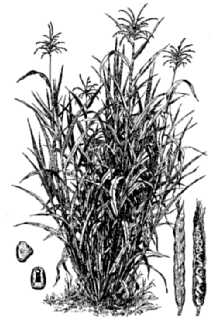Mexican Teosinte
Scientific Name: Zea mexicana (Schrad.) Kuntze

| General Information | |
|---|---|
| Usda Symbol | ZEME |
| Group | Monocot |
| Life Cycle | Annual |
| Growth Habits | Graminoid |
| Native Locations | ZEME |
Plant Guide
Use soil moisture sensors to measure the soil moisture of Mexican Teosinte.
Fact Sheet
Alternate Names
Teosinte, annual teosinte, Euchlaena mexicana
Uses
This species is used for wildlife, such as quail, dove, and turkey, food and habitat. It is also suitable for silage or green chop feed.
Status
Please consult the PLANTS Web site and your State Department of Natural Resources for this plant’s current status (e.g. threatened or endangered species, state noxious status, and wetland indicator values).
Weediness
This plant may become weedy or invasive in some regions or habitats and may displace desirable vegetation if not properly managed. Please consult with your local NRCS Field Office, Cooperative Extension Service office, or state natural resource or agriculture department regarding its status and use. Weed information is also available from the PLANTS Web site at plants.usda.gov. From Hitchcock (1950) @ plants.usda.gov
Description and Adaptation
Adaptation
Adaptation
Grass Family (Poaceae), Mexican teosinte is an annual, warm-season grass introduced from Mexico, It is similar to corn in general vegetative appearance and stands 10 to 15 feet in height, It is coarse, branches at the base, and the leaf blades are sword-shaped to 3 ¼ inches wide and 13 to 48 inches long, Clusters of slender “ears” (seed pods) are produced in each of the 5 to 7 uppermost leaf axils, Each ear normally contains 3 to 8 very firm glossy seeds with a marking resembling an insect pupa on the face, It is adapted to fertile soils ranging from somewhat poorly to well drained, It can grow wherever corn is grown, Approximately 165 to 170 frost free days are required from seeding to maturity, , Use soil moisture sensors to measure the soil moisture of Mexican Teosinte.
Establishment
The area to be planted should be plowed and thoroughly disked. The time for planting in Florida is early June. If irrigation is available and greater forage yield is desired, planting can be done in early April, weather permitting. Fertilizer requirements are similar to that for most grain crops. An application of N, P, and K should be based upon a soil test. For row planting, the width of the rows should be approximately the same as used for corn, placing the seed 1 to 2 inches deep. Use 8 to 10 pounds of seed per acre. For broadcast seeding, use 10 to 12 pounds per acre followed by shallow disking for seed coverage. Shattered seed will voluntarily germinate the following year. To encourage this production, till the soil by moderate to thorough disking in early march prior to germination.
